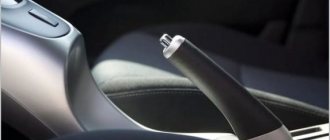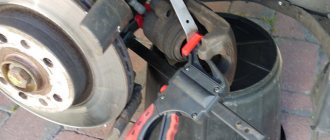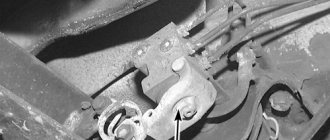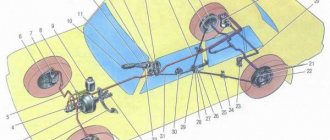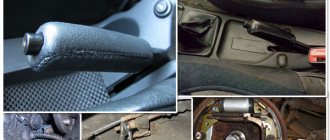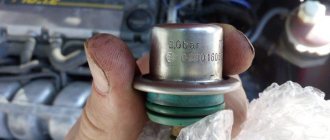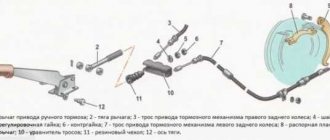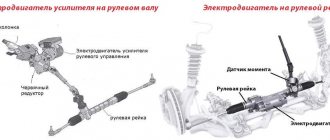An important part of any car is the parking brake, which locks the car in place while parked and prevents it from unintentionally rolling back or forward. Modern cars are increasingly equipped with an electromechanical type of parking brake, in which electronics replace the usual “handbrake”. The abbreviation for electromechanical parking brake “EPB” stands for Electromechanical Parking Brake. Let's look at the main functions of the EPB and its differences from the classic parking brake. Let's look at the elements of the device and the principle of its operation.
EPB device
The electromechanical handbrake is installed on the rear wheels of the car. Structurally, it consists of the following elements:
- brake mechanism;
- drive unit;
- electronic control system.
Electromechanical parking brake control circuit
The braking mechanism is represented by standard disc brakes of the car. Design changes affected only the working cylinders. The parking brake drive is installed on the brake caliper.
The electric handbrake drive consists of the following parts located in one housing:
- electric motor;
- Belting;
- planetary reductor;
- screw drive.
An electric motor drives a planetary gearbox via a belt drive. The latter, by reducing the noise level and weight of the drive, affects the movement of the screw drive. The drive, in turn, is responsible for the translational movement of the brake piston.
The electronic control unit consists of:
- input sensors;
- control unit;
- actuators.
Input signals come to the control unit from at least three elements: from the handbrake button (located on the center console of the car), from the slope sensor (integrated into the control unit itself) and from the clutch pedal sensor (located on the clutch drive), which fixes position and release speed of the clutch pedal.
The control unit, through sensor signals, influences actuators (such as a drive motor, for example). Thus, the control unit directly interacts with the engine control and directional stability systems.
Why do we need a working handbrake?
A hand brake is an element of the vehicle’s braking system, which performs the function of blocking the wheels relative to the axis of movement of the vehicle, and thus ensures the stability of the vehicle on the moving surface (including on a sloped surface).
A working handbrake performs the following functions:
1. Provides vehicle stability on the road surface when parked or on slopes.
2. Helps with emergency braking.
3. If you have the skills, you can use it to enter a controlled drift.
4. If the foot brake breaks down, it can perform its functions.
But it is worth noting that it is impossible to use the handbrake as a permanent braking element (instead of a foot brake), because its main purpose is to secure the car while parking. If you need to use the handbrake when braking while driving, it is not recommended to pull it sharply, as this will cause the car to skid.
The design and principle of operation of the hand brake are quite simple. It consists of three main components:
1. Mechanical drive.
2. Actuator.
3. Control node.
The mechanical drive is made in the form of a hand brake cable. This cable acts on the rear brake pads or on the transmission (depending on the design features of the car). The rocker arm installed in the handbrake ensures uniform cable tension on the two brake pads.
The actuator of the handbrake is the brake pads of the rear axle, which can be driven not only from the handbrake lever, but also from the foot brake pedal. This was done for simplicity of design and for easier vehicle maintenance.
The handbrake is activated by a control unit, represented by a handbrake lever with a ratchet, which controls the tension of the cable. It is located between the driver's seat and the passenger's seat in the central tunnel. On cars with an automatic transmission, there is a foot pedal for the parking brake instead of a lever.
We recommend: How to drain and refill antifreeze on a Lada Priora?
The activation of the handbrake is indicated by a sensor in the form of a light bulb on the dashboard. This sensor helps the driver navigate when the handbrake is on and remember to remove the car from the handbrake before starting to drive. In some cars, if you drive with the handbrake on, a beep will sound, which is very convenient, because drivers often forget to turn off the handbrake.
Working principle of EPB
The operating principle of the electromechanical parking brake is cyclical: it turns on and off.
EPB is activated using a button on the central tunnel in the car. The electric motor, through a gearbox and screw drive, attracts the brake pads to the brake disc. In this case, the latter is rigidly fixed.
Working principle of EPB as a cartoon
And the parking brake is turned off when the car starts. This action occurs automatically. You can also turn off the electronic handbrake by pressing the button while the brake pedal is already pressed.
During the process of turning off the EPB, the control unit analyzes parameters such as: the magnitude of the slope, the position of the gas pedal, the position and release speed of the clutch pedal. Thanks to this, it becomes possible to turn off the EPB in a timely manner, including shutdown with a time delay. This prevents the vehicle from rolling back when starting on an incline.
Most vehicles equipped with EPB have an Auto Hold button next to the handbrake button. This is very convenient for cars with automatic transmission. This function is especially relevant in city traffic jams with frequent stops and starts. When the driver presses the “Auto Hold” button, there is no need to hold down the brake pedal after stopping the car.
When stationary for a long time, the EPB turns on automatically. The electric parking handbrake will also engage automatically if the driver turns off the ignition, opens the door or unfastens the seat belt.
Advantages and disadvantages of EPB compared to a classic parking brake
For clarity, we present the pros and cons of EPB in comparison with the classic handbrake in the form of a table:
| Benefits of EPB | Disadvantages of EPB |
| 1. Compact button instead of a bulky lever | 1. Mechanical parking brake allows you to adjust the braking force, which is not available with EPB |
| 2. There is no need to adjust the EPB during operation | 2. When the battery is completely discharged, it is impossible to “remove the handbrake” |
| 3. Automatic shutdown of EPB when the car starts | 3. Higher cost |
| 4. No rollback of the car on an incline |
What to do
First of all, you need to check the battery. If everything is fine with it, and there is enough charge for normal operation, then the problem may be related to faulty wiring.
The second option is to carefully check the operation of the parking brake. To do this, you need to stand on an inclined surface, press the brake, put the car on the handbrake and check whether it will roll or not. To avoid an emergency, make sure in advance that there are no other cars nearby.
If the car starts moving, the handbrake is faulty. In this case, you will have to repair the parking brake by completely disassembling the box. If the car remains stationary, then the Electronic Parking Brake error is most likely due to the electronic sensor. It's much easier to fix than the box.
If you are an inexperienced driver and have little understanding of the car, then it is better to turn to professionals. If the car was purchased recently and the warranty period has not yet expired, then you need to contact the dealer. In other cases, it is better to go to a car repair service. You definitely cannot ignore the Electronic Parking Brake error. If you do not solve the problem in time, you may encounter unpleasant consequences on the road in the future.
Features of maintenance and operation of vehicles with EPB
Brake caliper design with an electromechanical parking brake
To check the functionality of the EPB, the vehicle must be placed on a brake stand and braked with the parking brake. In this case, the check must be carried out regularly.
Replacement of brake pads is carried out only when the parking brake is released. The replacement process takes place using diagnostic equipment. The pads are automatically installed in the desired position, which is recorded in the memory of the control unit.
Do not leave the car on the parking brake for a long time. When parked for a long time, the battery may discharge, making it impossible to remove the car from the handbrake.
Before carrying out technical work, it is necessary to switch the vehicle electronics into service mode. Otherwise, the electric handbrake may automatically turn on during vehicle maintenance or repair. This, in turn, can cause damage to the vehicle.
Pull the handbrake - your actions
Handbrake repair usually comes down to replacing the cable. But in most cases, to resume operation of the handbrake, it is enough to simply tighten it. And this is within the power of every driver.
If the handbrake is adjusted correctly, the number of clicks when tightening the lever should be 5-6. If the number of clicks is less or more, then an adjustment procedure needs to be carried out.
Adjusting the parking brake, regardless of its design features, is based on the principle of adjusting the gap between the brake pads (linings) and brake drums (discs). This gap is adjusted by changing the length of the handbrake cable (its tension), which is located under the interior panel at the bottom of the brake lever.
It is advisable to adjust the handbrake tension in an inspection hole, on a lift or on an overpass. As a last resort, you can use a jack and install support trestles under the rear of the car. There are car models in which the handbrake tension is adjusted directly in the car dealership (you can find out more about this in the operating instructions). In this case, you won’t have to bother with lifting the car.
Tensioning the handbrake consists of the following steps:
1. Raise the car and place it on a support (to have access to the bottom of the car).
2. Raise the handbrake lever 1-3 clicks.
3. Find and loosen the locknut from the adjusting device through the hole in the brake drum.
4. Tighten the adjusting nut and check the tension of the brake cable.
5. If the cable tension has not been achieved, then professional repair of the handbrake is necessary with replacement of its cable. To do this, it is better to contact specialists.
6. If the tension was successful, you need to check the operation of the handbrake by pulling the lever towards you. After this, try to rotate the rear wheel by hand. It should not rotate without effort. After this, you need to tighten the locknut, release the handbrake lever and carry out another similar test. In this case, the wheel should spin freely.
7. Lower the car to the ground and test the operation of the handbrake under real driving conditions. If something goes wrong and there is a suspicion that the problem has not been corrected, you should go through the described steps again or contact a repairman at a car service center.
The electromechanical parking brake frees the driver from the problem called “forgot to release the car from the handbrake.” Thanks to EPB, this process occurs automatically when you start driving. In addition, it makes it easier for the car to start uphill and makes life much easier for drivers in traffic jams.

